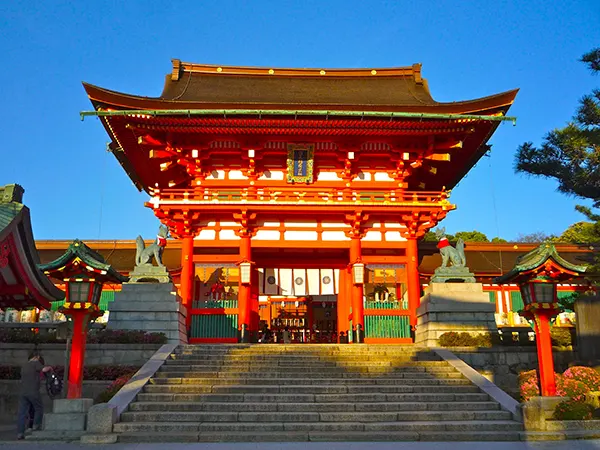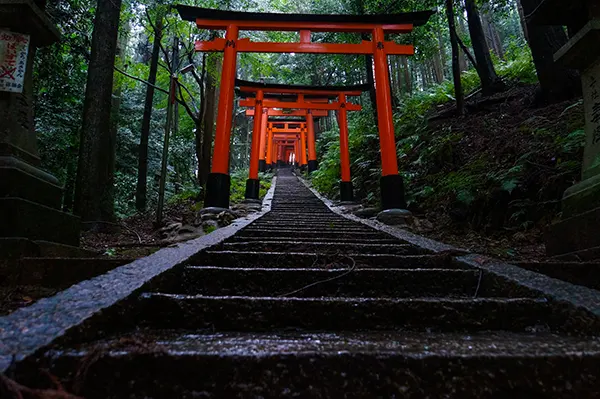Kyoto and the Fushimi Inari-taisha Shrine

Kyoto, the cultural heart of Japan, is a city where tradition and modernity coexist harmoniously. As one of the most historically rich cities in the country, Kyoto is home to thousands of shrines, temples, and heritage sites. Among these, the Fushimi Inari-taisha Shrine stands out as a spiritual and cultural landmark. Dedicated to Inari, the Shinto god of rice and prosperity, the shrine is famous for its thousands of vermilion torii gates that create a mesmerising tunnel leading up Mount Inari.
The History and Significance of Fushimi Inari-taisha
The Fushimi Inari-taisha Shrine dates back to 711 AD, making it one of Japan’s oldest and most revered Shinto shrines. Originally established on the Inariyama hill, it was later moved to its present location in 816 AD. The shrine is the head of approximately 30,000 Inari shrines across Japan, signifying its immense religious importance.
Inari, the deity honoured at the shrine, is believed to bring good fortune, prosperity, and success, making the site popular among merchants, business owners, and pilgrims. Fox statues, known as kitsune, are scattered throughout the shrine grounds, as foxes are considered the messengers of Inari.
Throughout history, the shrine has been expanded and reconstructed numerous times, with notable donations from powerful samurai and merchants. Today, it remains one of the most visited religious sites in Japan.
The Iconic Torii Gates
The most recognisable feature of Fushimi Inari-taisha is the Senbon Torii (thousands of torii gates). These gates line the trails leading to the summit of Mount Inari, creating a breathtaking passageway. Each torii is donated by individuals or businesses hoping to receive blessings and prosperity in return.
The torii gates bear inscriptions of the donors’ names, symbolising gratitude and devotion. The tradition of donating torii began in the Edo period and continues to this day, with new gates constantly being added.
Walking through the torii tunnel provides visitors with a sense of tranquillity and connection to Japan’s spiritual traditions. The full hike to the top of Mount Inari takes approximately two to three hours, rewarding visitors with panoramic views of Kyoto.
Exploring the Shrine Grounds
Beyond the iconic torii gates, Fushimi Inari-taisha offers several fascinating areas to explore. The main shrine building, or honden, features intricate wooden carvings and traditional architectural elements. Visitors can also witness sacred ceremonies performed by Shinto priests.
Scattered throughout the shrine complex are smaller sub-shrines, each dedicated to different aspects of Inari worship. These sub-shrines often include miniature torii gates, left by worshippers as offerings.
One of the notable stops along the hiking trail is the Yotsutsuji intersection, a resting point that offers stunning views of Kyoto city. This spot is popular among visitors who wish to admire the scenery without hiking the full trail.
Best Time to Visit and Travel Tips
Fushimi Inari-taisha is open 24 hours a day and does not charge an entrance fee, making it an accessible destination for travellers at any time. However, early mornings or late evenings are the best times to visit to avoid large crowds.
Spring and autumn are particularly scenic seasons, with cherry blossoms and vibrant autumn foliage enhancing the shrine’s beauty. The New Year period is another significant time when thousands of worshippers visit to pray for blessings.
For those travelling from Kyoto Station, the easiest way to reach the shrine is via the JR Nara Line, which takes around five minutes to Fushimi Inari Station. Alternatively, the Keihan Main Line provides access from the Fushimi Inari Station.

The Cultural Impact of Fushimi Inari-taisha
The shrine has played a significant role in Japanese culture, appearing in literature, art, and cinema. It has been featured in various films, including the famous scene in *Memoirs of a Geisha*, where the protagonist runs through the torii gates.
Local festivals, such as the Inari Matsuri, celebrate the deity with colourful processions, traditional performances, and food stalls offering local delicacies. These events provide a deeper insight into Kyoto’s spiritual traditions.
The influence of Fushimi Inari-taisha extends beyond Japan, inspiring visitors from around the world to learn more about Shinto beliefs and Japanese heritage.
Preservation and Future of the Shrine
Efforts to preserve the shrine involve continuous maintenance of the torii gates, shrine buildings, and surrounding nature. Donations from visitors and businesses help fund these conservation projects.
With growing tourism, local authorities work to balance visitor accessibility while maintaining the sacred atmosphere of the site. Conservation initiatives focus on protecting the natural environment of Mount Inari.
As one of Kyoto’s most iconic landmarks, Fushimi Inari-taisha will continue to serve as a cultural and spiritual destination for generations to come.
